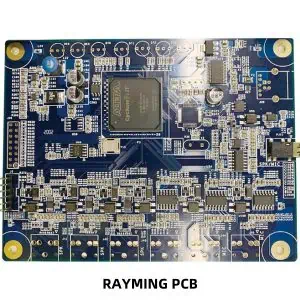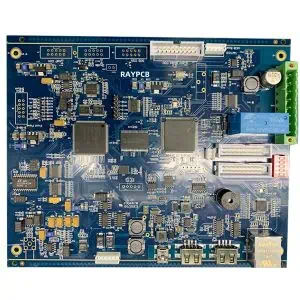The Automotive Brushless Water Pump Controller Printed Circuit Board Assembly (PCBA) is a critical component in modern vehicle cooling systems. This sophisticated electronic device manages the operation of brushless DC motors in water pumps, ensuring optimal engine temperature control and improved fuel efficiency. The design and manufacturing process of these controllers involves intricate engineering and precision production techniques.
Design Considerations
Functionality
The primary function of the controller is to regulate the speed and torque of the brushless DC motor in response to various inputs such as engine temperature, coolant flow rate, and vehicle operating conditions. The design must incorporate:
- Microcontroller unit (MCU) for processing and control logic
- Power stage for driving the motor
- Sensors for temperature and flow rate measurement
- Communication interfaces (e.g., CAN bus) for integration with the vehicle’s ECU
Environmental Factors
Automotive applications demand robust designs that can withstand harsh conditions:
- Temperature extremes (-40°C to 125°C)
- Vibration and shock resistance
- Electromagnetic Interference (EMI) protection
- Moisture and chemical resistance
Regulatory Compliance
The design must adhere to automotive industry standards such as:
- ISO 26262 for functional safety
- AEC-Q100 for automotive-grade electronic components
- EMC standards for electromagnetic compatibility
PCB Design
The PCB layout is crucial for the controller’s performance and reliability:
- Multi-layer design (typically 4 to 6 layers) for optimal signal routing and power distribution
- Careful placement of components to minimize electromagnetic interference
- Thermal management considerations, including copper pours and strategic via placement
- Incorporation of test points for manufacturing and in-field diagnostics
Component Selection
Choosing the right components is vital for the controller’s performance and longevity:
- Automotive-grade MCU with sufficient processing power and peripherals
- High-efficiency MOSFETs for the power stage
- Precision sensors for accurate temperature and flow measurements
- Robust passive components rated for automotive use
Manufacturing Process
The manufacturing of Automotive Brushless Water Pump Controller PCBAs involves several key steps:
-
PCB Fabrication: The bare PCB is manufactured according to the design specifications, including precise layer stackup and controlled impedance requirements.
-
Component Sourcing: All components are sourced from qualified suppliers, ensuring traceability and compliance with automotive standards.
-
SMT Assembly: Surface Mount Technology (SMT) is used to place and solder components onto the PCB. This process typically involves:
- Solder paste application using stencil printing
- Automated component placement with pick-and-place machines
- Reflow soldering in a controlled temperature profile
-
Through-Hole Assembly: Any through-hole components are inserted and soldered, often using wave soldering techniques.
-
Inspection and Testing: Rigorous quality control measures are implemented:
- Automated Optical Inspection (AOI) for solder joint and component placement verification
- X-ray inspection for hidden solder joints
- In-Circuit Testing (ICT) to verify electrical connections and basic functionality
- Functional testing to simulate real-world operation
-
Conformal Coating: A protective coating is applied to shield the PCBA from moisture, dust, and chemicals, enhancing its durability in automotive environments.
-
Final Assembly: The PCBA is integrated into its housing, often with thermal interface materials for heat dissipation.
-
End-of-Line Testing: Comprehensive testing is performed to ensure the controller meets all functional and safety requirements.
Quality Assurance
Maintaining high quality standards throughout the design and manufacturing process is paramount:
- Implementation of statistical process control (SPC) to monitor and improve manufacturing consistency
- Adherence to automotive quality management systems such as IATF 16949
- Regular audits and continuous improvement initiatives
- Stringent documentation and traceability measures





